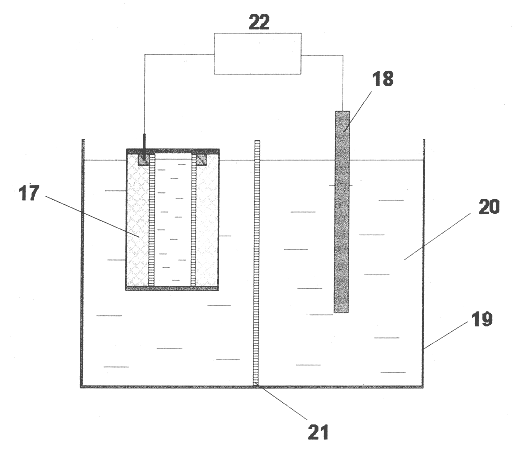Composite regenerable adsorption carbon material and its regeneration method
- Summary
- Abstract
- Description
- Claims
- Application Information
AI Technical Summary
Benefits of technology
Problems solved by technology
Method used
Image
Examples
example 2
Table 3 shows experimental data characterizing the dependence of the regeneration degree on the ratio of specific volumetric electric conductivity of CRAC and electrolyte. The adsorbent mass is 1 g, the adsorbed substances are benzene and phenol, the electrolyte is sodium sulphate, the regeneration parameters are 8 V voltage at cell, 0.01 A / g specific current density, 1 hour regeneration time.
To attain the high degree of regeneration the required condition is that the specific volumetric electric conductivity of CRAC must differ from the specific volumetric electric conductivity of electrolyte by not more than one order of magnitude. If this ratio is not observed, the regeneration degree decreases to 70% and less.
example 3
The experiment on adsorption and regeneration was carried out by the above described methods. The adsorbed substances were phenol, hydroquinone, benzene and chloroform. The regeneration parameters implied the adsorbent with specific volumetric electric conductivity 40.3 (Ohm*.quadrature.m).sup.-1. The composite regenerable adsorption carbon material was a porous matrix made of activated carbon fibers of average fiber length of 1 mm to 5 mm and 1 to 30 micron diameter, the methylene blue adsorption capacity being 300 mg / g, and nonactivated carbon fibers 2 to 30 micron in diameter and average length of 2 to 30 micron. The adsorption surface area was 1100 m.sup.2 / g)--activated carbon fiber--1 g+nonactivated carbon fiber--0.2 g.
The solution volume in finding the capacity was 400 cm.sup.3, and the recirculation rate was 50 cm.sup.3 / min. The regeneration parameters implied that the adsorbent was engaged as cathode, the specific current density was 0.1 A / g, the electrolyte was 100 g / dm.s...
example 4
The adsorbent had a specific volumetric electric conductivity 40.3 (Ohm*.quadrature.m).sup.-1. Composite regenerable adsorption carbon material in form of a porous matrix made of activated carbon fibers of 1 mm to 5 mm average fiber length and 1 to 30 micron in diameter, and having a methylene blue adsorption capacity of 300 mg / g, and nonactivated carbon fibers 2 to 30 micron in diameter and with average length of 2 to 30 mm. The adsorption surface area made 1100 m.sup.2 / g)--activated carbon fiber 1 g+nonactivated carbon fiber 0.2 g.
The solution volume in finding the capacity is 400 cm.sup.3. The recirculation rate is 50 cm.sup.3 / min. Sodium chloride and sulphide and potassium carbonate were used as electrolytes to fill the cell in the course of regeneration. The regeneration parameters imply that the adsorbent is engaged as cathode, the specific current density is 0.1 A / g, the voltage drop at the entire cell is 8 V, the time being 40 min.
The results are given in Table 8. The symb...
PUM
| Property | Measurement | Unit |
|---|---|---|
| Diameter | aaaaa | aaaaa |
| Diameter | aaaaa | aaaaa |
| Electrical resistivity | aaaaa | aaaaa |
Abstract
Description
Claims
Application Information
 Login to View More
Login to View More - R&D
- Intellectual Property
- Life Sciences
- Materials
- Tech Scout
- Unparalleled Data Quality
- Higher Quality Content
- 60% Fewer Hallucinations
Browse by: Latest US Patents, China's latest patents, Technical Efficacy Thesaurus, Application Domain, Technology Topic, Popular Technical Reports.
© 2025 PatSnap. All rights reserved.Legal|Privacy policy|Modern Slavery Act Transparency Statement|Sitemap|About US| Contact US: help@patsnap.com


